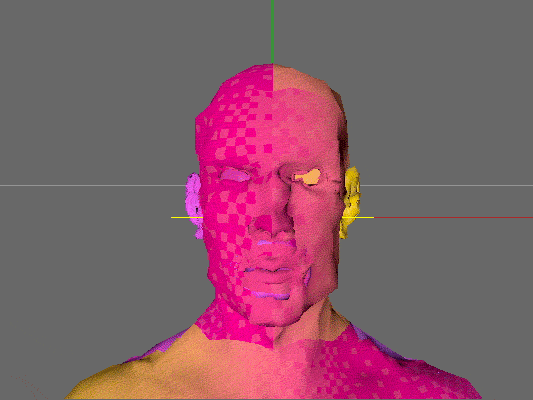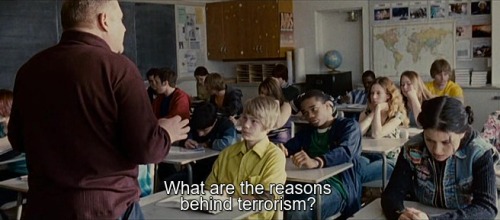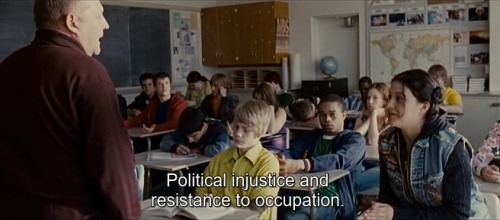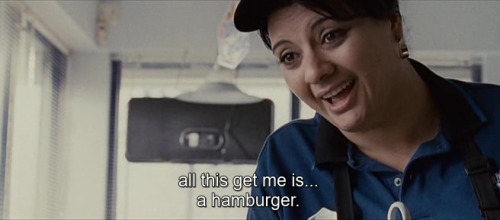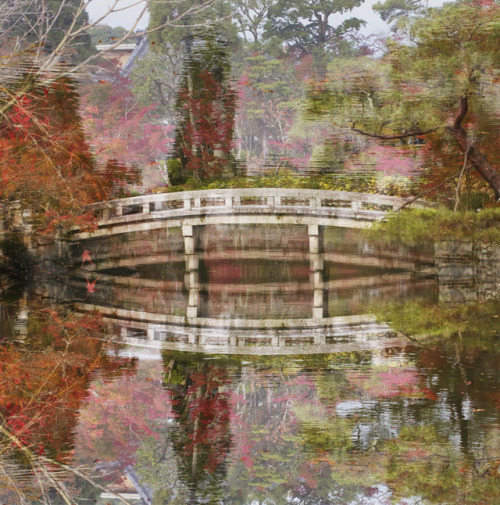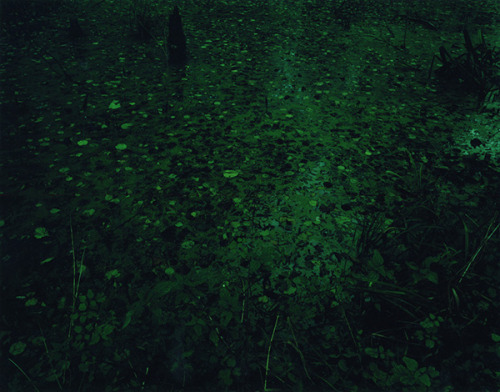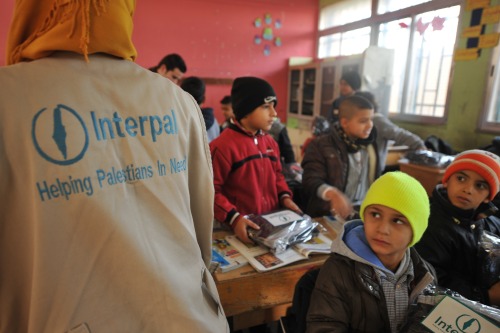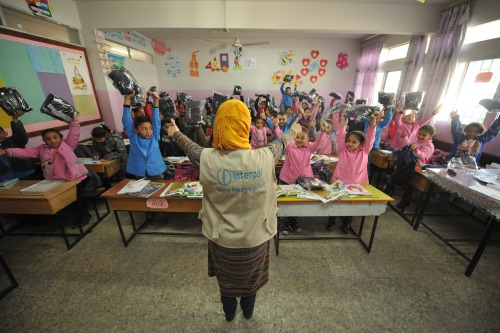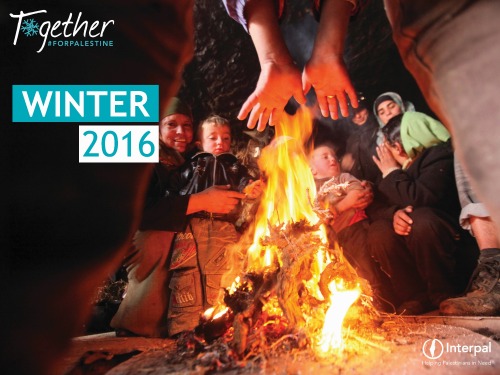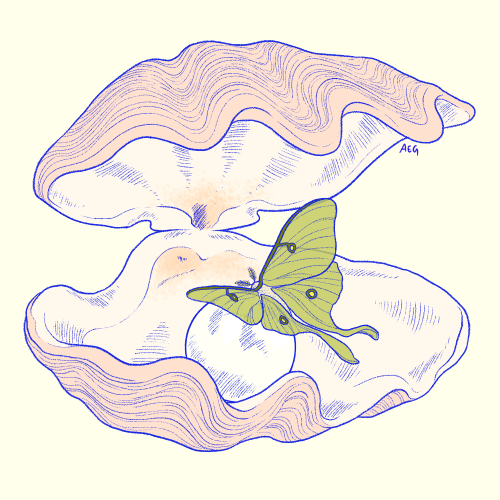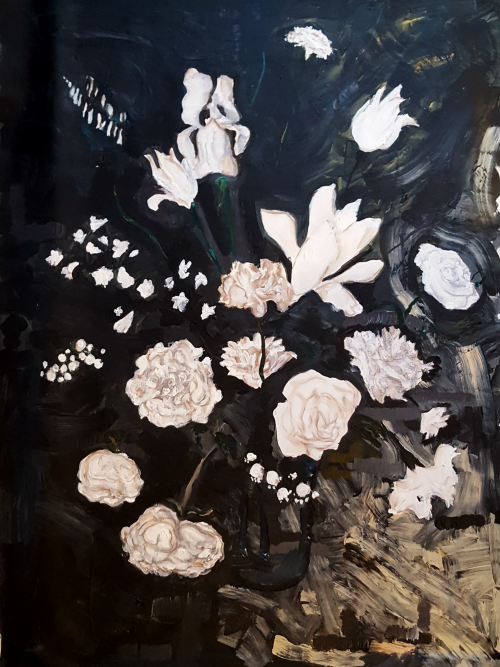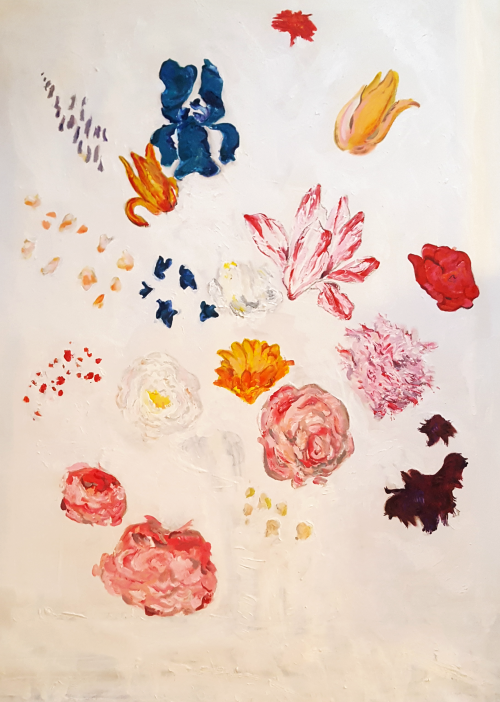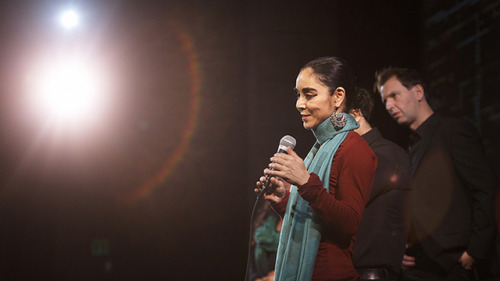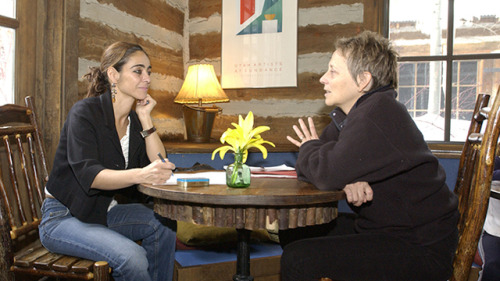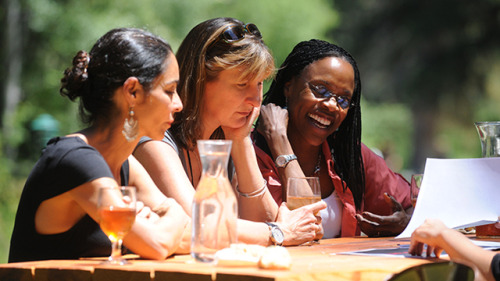#displacement
“Floating Tree” (2016)
″Floating Bridge” (2016)
″Hide and Seek: Swamp #01″ (2009)
“Hide and Seek: Green Swamp” (2008)
from sleepless nights
Ori Gersht at CRG Gallery @crggallery
April 19 – May 21, 2017
Post link
… is a differential equation:

where acceleration a(t), velocity v(t), and displacement s(t) are all vectors and functions of time. This equation is second-order in position because the highest derivative is the second time derivative of position. Combined with the right boundary conditions, s(t) (also called the trajectory: path through space and time) can be determined.
This differential equation can be solved one component, or dimension, at a time. Let us focus on one of these, and call it the x component. The equations for y and z can be found exactly the same way.
Constant acceleration
If the graph of a(t) signifying acceleration in the x direction is constant


then the graph of v(t), the velocity in the x direction, is a straight line with slope a0


and the graph of x(t), the position along the x axis, is a parabola


It is also possible for the acceleration, or either of the initial velocity or initial position, to be negative. Thus the displacement/projectile motion formula is derived.
As part of our 2016/17 Winter Appeal we distributed 2,000 winter clothing kits for refugee children in Rashidiyeh and Borj Al Shamali camps.
Thanks to your generous donations we are able to continue distributing aid to school children in Lebanese refugee camps.
To donate, call 0208 961 9993 or click the ‘Donate’ button at the top of our Page.
Post link
Cold hands, warm hearts
One of our Sponsorship Assistants reflects on the winter and her role in securing vital lifelines for children in need.
It is mid-winter and the cold is the only thing on my mind. Before I make a start on my work for the day I notice an unusual flush creeping over my complexion. The hint of heat on my cheeks thaws my cold hands so I cradle my face for a few minutes. I stop typing, I stop working and I start thinking.
***
I work in Interpal’s sponsorship department, processing requests and donations and delivering feedback from our projects in the field. In a nutshell, my role entails helping thousands of Palestinian children and their families to secure much needed aid. From my perspective, I see the donations process in its entirety, mediating between donors, staff in the field offices and our beneficiaries.
In amongst the administrative duties and everyday office tasks I have the unique privilege of hearing the stories of extraordinary children and their families. Even though I do not physically meet them, I am privy to intimate details about their lives. I know what they look like, (now and how they have changed and matured over the years), what they study at school, their aspirations and dreams for the future. But I also know of their difficulties. I see them grow up and vicariously experience their every joy and hardship from the distance of our office in London as they live through one of the most shameful periods in contemporary history; the Palestinian refugee crisis. Extraordinary children in extraordinary circumstances. The protracted displacement of the Palestinians is the longest running refugee crisis of our era and has now spilled over into the complications of other conflicts in the region, further muddying the waters until the international community finds it increasingly difficult to separate one set of causes from the effects of another.
Winter in London is a familiar visitor but one I cannot quite get used to. Of course, it has its moments of beauty, moments I enjoy best in my house, under the bed covers, tucked up in flannel pyjamas and drinking a steaming cup of hot chocolate. The long winter months seem to stretch out forever and it strikes me that despite any discomfort I may face, every year thousands of lives at home and abroad are lost because of vulnerability and our failure to act swiftly and humanely.
The winter is also a time of reflection, celebration and thankfulness. Year in year out, I am reminded of my many privileges. The list is endless, including in it the many inalienable social, political and economic freedoms we enjoy, but on a cold winter day like today, and even more on colder nights, I find myself ironically adding to my mental list the freedom from having to make the hard choices between feeding myself and my family and freezing to death.
Most people don’t realise just how cold it can get in the Middle East. The idea that people can freeze to death in a place that is so often characterised by desert heat and the image of a burning sun seems unimaginable. However, winters in Palestine are as harsh as ours if not more so, as our planet’s changing climate brings with it unexpected new weather patterns, catching people unprepared and thus engineering a catastrophe.
Other than the superficial comparisons my imagination can muster, I cannot comprehend the realities enough to authentically feel their emotions. I get first hand reports from our field offices, trawl through figures and statistics, listen to anecdotes, scroll through pictures and sometimes even videos. But what are facts to a distant and disconnected mind? Our minds can crunch numbers and register emotions, but even the power of empathy cannot fully feel what it is like to be a Palestinian refugee.
Many of the families I deal with directly do not have means of heating themselves or their property. Still more cannot afford winter clothing and do not even possess enough clothes to be able to layer up - one of the main winter safety tips offered by the NHS. Others are without shelter due to lasting damage or destruction from successive shelling and war. Food is also scarce and in the winter an empty stomach can increase the likelihood of death. Moreover, the healthcare facilities in the region are under-equipped due to the tight restrictions on what is allowed in and out of the territory. Social security is almost non-existent and many people are trapped in legal and political quagmires. This is an over-simplification of their struggle, of course, just know that the odds are not stacked in their favour.
This is why I cannot help but pay attention to the cold creeping over me. The shivering, the shuddering, and the stiff discomfort all strike me as stark reminders of my privilege. What about those living in the crowded refugee camps of Gaza, Lebanon and Jordan, and in the occupied territories of the West Bank? What about their parents, grandparents, their friends, their communities, all of whom are fighting to survive the cold amidst all of their other daily struggles?
My thoughts are interrupted once more by the incessant creeping of the cold. I, unlike Palestinian children and family, am well equipped to fight the winter and its blues. Almost without thinking, I flick the switch on the electric heater stationed neatly under my desk and take a long sip of my hot cup of tea, a British tradition I proudly claim during the winter months.
As I write this, I reflect on the ways in which we should not feel guilty for the privilege of warmth and wealth, but instead put these comforts to good use. Let us warm the hands and hearts of those who are struggling to survive the winter, and revive another great British tradition in this festive season, that of generously giving and caring about those in need.
Post link
Lalo de Almeida, Amazonian Dystopia (2009-2021) for Folha de São Paulo.
This 2013 photograph shows the construction of a power plant on the Xingu River in Brazil. More than 80% of the river’s water has been diverted from its natural course, creating severe consequences for the people that live on its shores.
Long-Term Project Award / World Press Photo Awards
Post link


Next up is Displacement by Kiku Hughes. The concept for this one is very interesting and I’m excited to finally dive into this story. I think this is the first graphic novel I’ve read about the Japanese American internment camps during WWII. George Takei’s They Called Us Enemy is another graphic novel about the subject and it as been on on tbr list for a while so I’ll have to check my library’s website to see if they’ve got it. Fingers crossed.
Some beautifully hand crafted portraits from an unknown Afghani sculptor. 1980s
#Refugee #Artist #Displacement #Heritage #Wood #Sculpture #Beaut #Beautiful #Art #ForeignArtistsInIndia #Unknown #Portrait #IndianAesthetic #Afghan #HandMade #HandCarved #Nodia #NewDelhi #DelhiDiaries #DelhiJournal #Capital #India #Wanderer #Wanderlust #Travel #Travelogue #TravelDiaries (at Noida, India)
https://www.instagram.com/p/BnIXRZGFon5/?utm_source=ig_tumblr_share&igshid=1s1vy7z07b9ln
Post link
Acclaimed artist and long-time Sundance alum Shirin Neshat just opened her retrospective Shirin Neshat: I Will Greet the Sun AgainatThe Broad in Los Angeles.
Taking its title from a poem by Iranian poet Forugh Farrokhzad, the exhibition (which presents over 230 photographs and eight immersive video installations works) offers a rare glimpse into the evolution of Neshat’s artistic journey as she explores topics of exile, displacement, and identity with beauty, dynamic formal invention, and poetic grace.
The exhibition is open now through February 16, 2020.
1: Shirin Neshat during Women Without Men Festival premiere, © 2010 Sundance Institute | Photo by Brandon Joseph Baker; 2: Shirin Neshat and Creative Advisor Naomi Foner during the January Screenwriters Lab; © 2003 Clayton Chase for Sundance Institute; 3: Artist Trustees Shirin Neshat and Charlayne Woodard (left, right) with Trustee Jeanne Donovan Fisher (center), during the Institute Board Retreat; © 2009 Fred Hayes for Sundance Institute.
Post link
Hello everyone! While we are working on our first issue, we wanted to share with you what has been informing our thought processes, what inspires us, and some resources we have been working from. At Mesh Archive, we want to provide as much access to resources as we can, and many of these resources are typically under the radar. These are our personal archives; we hope to bridge these gaps with you and encourage you all to share with us what informs yourlearning!
The Hyper-affective Turn: Thinking the Social in the Digital Age
Nestor García Canclini and Maritza Urteaga discuss the shift of many 21st-century social theorists toward affect studies and how this has affected as well as been formed by digitization.
‘I WILL DO EVERYthing That Am Asked’: Scambaiting, Digital Show-Space, and the Racial Violence of Social MediabyLisa Nakamura
“Memes that depict the black body in abject and bizarre poses and situations are part of the long history of viral racism that spreads using user and audience labor.”
Pao Out as Reddit CEO; Co-Founder Huffman Takes Over
“The social news service has thousands of loyal, unpaid moderators who produce and curate the lion’s share of content on the site. But a staff firing and the controversy that erupted thereafter yesterday has moderators of some of the most influential and important parts of the site closing off their sections in protest, posing a serious problem for Reddit’s future … “
Monoskop is a wiki for collaborative studies of the arts, media and humanities (Monoskop About). This is a large database of resources that can helpful in exploring some other concepts in relation to what we have been talking about.
Mindy Fullilove – Reading about Displacement
A collection of research and resources by Mindy Fullilove, who has provided a profound amount of her research online for access concerning displacement in relation to black women and community, housing, family, and AIDS.
Center for Art and Thought is a network of artists, scholars, and activists who use the internet as a platform to showcase the variety of works being produced out of the Filipinx diaspora (CA+T About). They have collections of work, art, essays, and exhibitions speaking to the digital era and importance of access to resources that inform learning.
Jane Jin Kaisen is Korean transnational adoptee who works with a variety of artforms that explore representations of memory, history, and transnational subjectivity (Jane Jin Kaisen About). She has produced an incredible amount of works surrounding this fairly difficult concepts such as her film The Woman, The Orphan, and The Tiger, which can be found here.
Chapter One of Queer Phenomenology by Sara Ahmed
Queer Phenomenology explores orientation — a turn of the body toward objects — as well as the significance of objects’ physical impressions upon the body. Much of Ahmed’s work focuses on the occupation of spaces and bodies and the politics of those spatial-material interactions.

